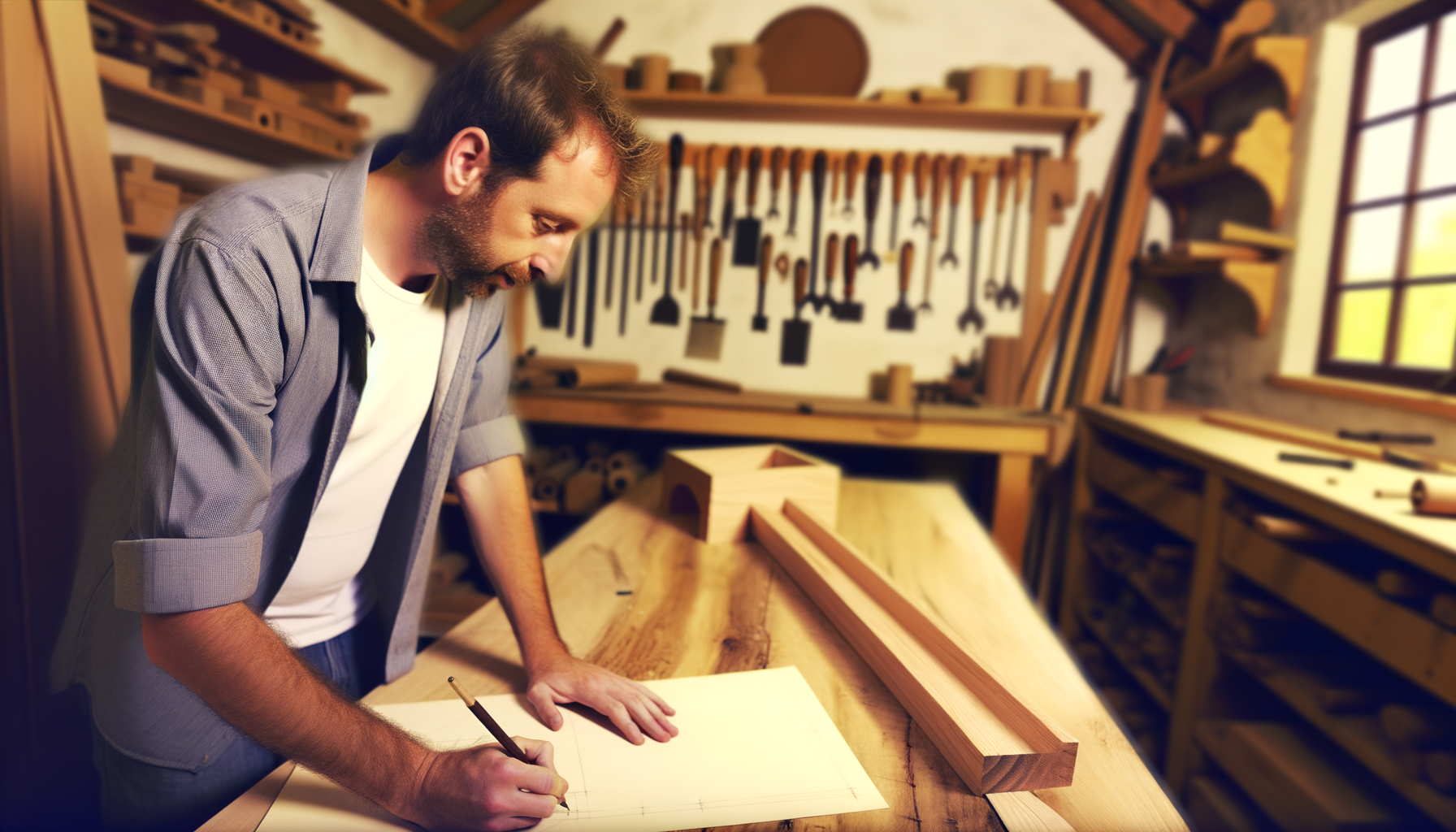Introduction to Sketching for Woodworking
The Importance of Sketching in Woodworking
Sketching is an indispensable part of woodworking that serves as the bridge between a woodworker’s vision and the tangible creation. It is the first step in bringing an idea to life, allowing the artisan to explore different designs, dimensions, and details before committing to the physical work. A well-crafted sketch not only guides the woodworker through the construction process but also helps in visualizing the end product, ensuring that the piece is both aesthetically pleasing and functionally sound. Michael Cullen, a renowned furniture designer and craftsman, emphasizes the significance of sketching in his work, using it as a tool to refine his designs and communicate his ideas effectively.
Understanding the Connection Between Sketching and Craftsmanship
Sketching is more than just drawing lines on paper; it is a form of communication that conveys the woodworker’s intent and demonstrates their understanding of the material and the craft. The act of sketching fosters a deeper connection with the project, as it requires the woodworker to consider the wood’s properties, the joinery, and the overall structure. This intimate knowledge of the project’s components enhances the quality of craftsmanship, as it allows for adjustments and improvements to be made before the saw touches the wood. The connection between sketching and craftsmanship is evident in the works of ancient civilizations, where meticulous planning and design were integral to their revered wooden artifacts.
Setting the Stage: Tools and Mindset for Effective Sketching
To master the art of sketching for woodworking projects, one must be equipped with the right tools and mindset. Essential sketching tools include a variety of pencils, from hard leads for fine lines to soft leads for shading, as well as erasers, rulers, and compasses for precision. Choosing the right paper is also crucial; a heavier weight paper can withstand repeated erasing and refining, while grid paper can be helpful for maintaining proportions.
However, beyond the physical tools, the woodworker’s mindset plays a critical role. Effective sketching requires patience, attention to detail, and the willingness to iterate. It’s a process of exploration and refinement, where initial ideas evolve into detailed plans. Embracing this process with an open mind and a focus on the end goal will lead to more successful and satisfying woodworking projects.
In conclusion, sketching is a fundamental skill that lies at the heart of woodworking. It is a critical step that connects the initial concept to the finished piece, embodying the woodworker’s craftsmanship and attention to detail. By setting the stage with the proper tools and mindset, woodworkers can harness the full potential of sketching to create exceptional works of art.
Fundamentals of Sketching
Basic Sketching Techniques and Terminology
Mastering the art of sketching begins with understanding the foundational techniques and terminology. Freehand concept sketching is the initial stage where ideas take a rough shape on paper without concern for precision. This stage is about capturing the essence of the design, allowing for creativity and adjustments. As the design progresses, refined drawing techniques come into play, such as creating crisp lines, symmetry, and fair curves. Orthographic projections, or three-view drawings, are used to represent the design in true proportions, while isometric projections offer a three-dimensional view, showing how all parts relate to one another.
Choosing the Right Paper and Pencils
The choice of paper and pencils can significantly affect the quality of your sketches. For woodworking, a medium-weight paper that can withstand repeated erasing and redrawing is ideal. Pencils range from hard (H) grades, which produce lighter lines, to soft (B) grades for darker lines. A range of pencils from 2H to 4B is typically sufficient for most woodworking sketches, allowing for both fine lines and shading.
Perspective Drawing: Bringing Depth to Your Sketches
Perspective drawing is crucial for bringing depth and realism to your sketches. It involves drawing objects in a way that mimics how they appear to the eye in three dimensions. One-point perspective uses a single vanishing point on the horizon line, while two-point perspective uses two vanishing points, offering a more dynamic view of the object. Mastering perspective drawing allows woodworkers to create more lifelike and accurate representations of their projects.
Proportions and Measurements: The Key to Precision
Accurate proportions and measurements are the backbone of successful woodworking sketches. They ensure that the final product is both aesthetically pleasing and functional. Using a scale ruler can help translate the real-world dimensions onto paper accurately. It’s essential to check and recheck measurements throughout the sketching process to avoid costly mistakes during the build. Annotations on sketches can also provide clarity on dimensions and assembly details.
From Sketch to Sawdust: Translating Drawings into Projects
Interpreting Sketches into Woodworking Plans
Transitioning from the conceptual world of sketching to the tangible realm of woodworking requires a clear understanding of how to interpret sketches into actionable plans. A sketch is more than just a visual aid; it is a roadmap that guides the woodworker through the construction process. To effectively translate a sketch into a woodworking plan, one must consider the dimensions, materials, and joinery depicted in the drawing. It is crucial to envision the end product in three dimensions and understand how each component fits together. This mental exercise ensures that the plan is viable before any wood is cut.
Detailing and Annotating Your Sketches for Clarity
Detailing and annotating sketches are essential for clarity and precision. A detailed sketch includes all necessary measurements, angles, and notes on specific joinery techniques. Annotations can also highlight areas that require special attention, such as the orientation of wood grain for aesthetic or structural reasons. For instance, the shimmer and pop of figured maple, with its ornery wavy grain, can be maximized by noting the direction of the grain in the sketch. Annotations serve as reminders and instructions during the woodworking process, reducing the likelihood of errors and ensuring that the final product aligns with the original vision.
Avoiding Common Mistakes in Sketch-to-Project Translation
- Overlooking Material Characteristics: Each wood type has unique properties that can affect the project. For example, the hardness and grain pattern of curly maple can influence the ease of carving and finishing. Always consider these factors in your sketches.
- Ignoring Scale and Proportions: Ensure that the dimensions in your sketches are to scale and that proportions are accurate. This prevents misjudgments in size and fit when translating the sketch to the actual project.
- Forgetting to Account for Joinery: Joinery details are often underestimated in sketches. Clearly indicate the type of joinery in your plans to avoid complications during assembly.
- Lack of Detail: A sketch that lacks detail can lead to guesswork and improvisation, which may compromise the project’s integrity. Include as much detail as possible to guide your work.
By meticulously interpreting sketches into woodworking plans, detailing and annotating for clarity, and avoiding common translation mistakes, woodworkers can bridge the gap between concept and creation. This process ensures that the beauty envisioned in the initial sketch is fully realized in the finished woodworking project.
Advanced Sketching Techniques for Woodworkers
Shading and Texturing: Adding Realism to Your Sketches
Shading and texturing are pivotal in transforming a flat sketch into a lifelike representation of your woodworking project. Shading gives your drawing depth, indicating where light falls and where shadows are cast. To master shading, practice with a range of pencils from hard (H) grades to soft (B) grades, as each provides different tones. Use techniques like cross-hatching or stippling to create texture and depth. Texturing is equally important, as wood has a unique grain that should be represented in your sketches. Observe the patterns in wood and replicate them using fine lines and shading to give a realistic portrayal of the material’s surface.
Incorporating Color: When and How to Use It
While most woodworking sketches are monochromatic, color can be a powerful tool to convey additional information. Use color sparingly to highlight important features or to differentiate between various components of a project. Colored pencils or markers can indicate different types of wood or finishes. However, ensure that the use of color enhances rather than overwhelms your sketch. It should clarify, not confuse, the viewer about your project’s details.
Creating Exploded Views for Complex Projects
For complex projects with multiple parts, an exploded view can be invaluable. This technique separates each component of your project and spaces them apart as if in mid-explosion. This allows you to illustrate how parts fit together without the overlap that can occur in a traditional sketch. Start by drawing the core component and then add each subsequent part in relation to the core, ensuring that all connection points are clearly visible. Exploded views are particularly helpful for visualizing joinery and assembly sequences.
Using Templates and Stencils for Repeated Patterns
When your woodworking project includes repetitive patterns or shapes, templates and stencils can save time and increase accuracy. Create or purchase templates for common shapes, and use them to maintain consistency throughout your sketch. For intricate or custom patterns, design your own stencil to ensure that each repetition is identical. This consistency in your sketches will translate to precision in your woodworking, as you’ll have a reliable guide for creating multiple instances of the same shape or pattern.
By incorporating these advanced sketching techniques, woodworkers can create detailed and realistic plans that serve as a solid foundation for their projects. Remember, the quality of your sketches can greatly influence the outcome of your woodworking, so invest time in honing these skills.
Digital Sketching: Modern Tools for the Traditional Woodworker
Introduction to Digital Sketching Software
As woodworking enters the digital age, the traditional pencil and paper approach to sketching has been complemented by the advent of digital sketching software. These modern tools offer woodworkers a new realm of possibilities for designing and planning their projects. Digital sketching software, such as CAD (Computer-Aided Design) programs, allows for precise and editable drawings, providing a platform where ideas can be tested and refined with ease.
Benefits of Digital Over Traditional Sketching
While traditional sketching has its charm and practicality, digital sketching offers several distinct advantages:
- Accuracy and Precision: Digital tools provide an unparalleled level of accuracy, with the ability to draw exact lines, shapes, and measurements, crucial for the detailed nature of woodworking projects.
- Efficiency: Modifications to designs can be made quickly without the need to start from scratch, saving valuable time and resources.
- Visualization: 3D modeling capabilities allow woodworkers to visualize their projects from every angle, identifying potential design issues before they arise in the build process.
- Repeatability: Templates and designs can be saved and reused for future projects, ensuring consistency and the ability to scale up production if desired.
- Collaboration: Digital sketches can be easily shared with clients or collaborators, streamlining the feedback and approval process.
Combining Hand Sketching with Digital Enhancements
Despite the benefits of digital sketching, hand drawing remains an invaluable skill for capturing the essence of a design quickly and intuitively. Many woodworkers find a hybrid approach to be the most effective, starting with a hand-drawn concept before moving to digital software for refinement. This combination leverages the spontaneity and natural feel of hand sketching with the technical prowess of digital tools.
For instance, a woodworker might begin with a rough pencil sketch to explore the form and function of a piece. Once the concept is solidified, the sketch can be scanned or photographed and imported into a digital sketching program. Here, precise measurements and adjustments can be made, and the design can be rotated and viewed in three dimensions. This process not only saves time but also allows the woodworker to maintain the original creative spark that emerged during the hand-drawing phase.
In conclusion, digital sketching tools are not here to replace the traditional methods but to enhance them. By embracing these modern tools, woodworkers can elevate their craft, ensuring that their projects are not only functional and beautiful but also efficiently planned and executed.
Case Studies: Sketching in Action
Furniture Design: From Concept to Creation
The journey from a mere concept to a tangible piece of furniture is a testament to the power of sketching in woodworking. For instance, consider the creation of a custom chair. The initial sketches allow the woodworker to visualize the form, dimensions, and joinery details. These sketches evolve into detailed plans, often including side, front, and top views, as well as cross-sections to clarify complex areas. The ability to iterate on paper before making the first cut is invaluable, saving time, materials, and ensuring the final product aligns with the initial vision. A case in point is the iconic Eames Lounge Chair, which underwent numerous sketches and prototypes before becoming the classic it is today.
Decorative Carving: Sketching as a Guide for Intricate Work
Sketching is particularly crucial in decorative carving, where precision and symmetry are paramount. A woodcarver working on an ornate mantelpiece, for example, would start with a series of detailed sketches to establish the motifs and patterns. These sketches serve as a roadmap during the carving process, guiding the craftsman’s chisels and gouges to create the envisioned patterns. The sketches also help in maintaining proportion as the work progresses, ensuring that the final piece is balanced and harmonious. The renowned Grinling Gibbons’ cascades of flowers, fruits, and foliage in wood were all born from meticulous sketches that translated into his exquisite carvings.
Restoration Projects: Using Sketches to Preserve Authenticity
In restoration, sketches play a pivotal role in preserving the authenticity of the piece. When restoring a vintage piece of furniture, a restorer must understand the original craftsman’s intent. Detailed sketches of the existing conditions, as well as research into historical designs, help restorers make informed decisions about materials, construction techniques, and finishes. For example, restoring a piece of Chippendale furniture requires not only an understanding of the style’s characteristics but also the ability to replicate them. Sketches become a bridge between historical accuracy and practical execution, ensuring that the restored piece remains true to its era.
In conclusion, sketching is an indispensable tool in woodworking that aids in design, execution, and restoration. It is the language through which woodworkers communicate ideas, solve problems, and preserve the craft’s rich heritage. As seen in these case studies, whether it’s bringing a new piece of furniture to life, intricately carving wood, or restoring a historical piece, mastering the art of sketching is essential for success in woodworking projects.
Conclusion: Cultivating Your Sketching Skills
Practice Makes Perfect: Developing a Sketching Routine
As with any skill, consistent practice is the cornerstone of improvement in sketching. Developing a daily or weekly sketching routine can significantly enhance your ability to translate ideas onto paper. Start by setting aside a specific time each day dedicated to sketching. This could be as little as fifteen minutes or as long as an hour, depending on your schedule. Focus on different aspects of sketching during each session, such as perspective, shading, or proportions. Over time, you’ll notice an improvement in your speed, confidence, and accuracy.
Joining a Community: Sharing and Learning from Fellow Woodworkers
Woodworking, much like sketching, is a craft enriched by the shared experiences of its community. Joining a local woodworking club or online forum can provide invaluable support and knowledge. Sharing your sketches with fellow woodworkers can open up constructive feedback and new ideas. Likewise, observing the sketches of others can inspire and teach you different approaches and techniques. The camaraderie found in these communities often leads to collaborative projects, skill exchanges, and lifelong friendships.
The Lifelong Journey of Mastering Sketching in Woodworking
Mastering the art of sketching for woodworking is a lifelong journey that evolves with every project you undertake. As you grow as a woodworker, your sketching skills will also develop, reflecting the increased complexity and refinement of your work. Embrace the learning process, and don’t shy away from challenging projects that push the limits of your current abilities. Remember, each line you draw brings you one step closer to the masterful articulation of your woodworking visions. Celebrate your progress, and always strive to elevate your craft to new heights.
Remember, the journey of mastering sketching in woodworking is not a race but a marathon. With patience, practice, and a willingness to learn, your sketches will not only guide your projects but also become works of art in their own right. So, grab your pencil, clear your mind, and let your creativity flow onto the blank canvas before you.






